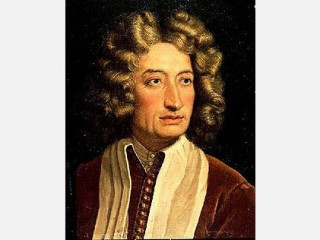
Arcangelo Corelli biography
Date of birth : 1653-02-17
Date of death : 1713-01-08
Birthplace : Fusignano, Italy
Nationality : Italian
Category : Famous Figures
Last modified : 2010-12-20
Credited as : Composer and violonist, ,
Arcangelo Corelli was an Italian composer and violinist. His instrumental works established the chamber music style and form of the late baroque era, and he founded the modern school of violin playing.
Arcangelo Corelli was born in Fusignano on Feb. 17, 1653. At the age of 13 he went to Bologna, where his main teacher was Leonardo Brugnol, a native of Venice. Corelli studied in Bologna until 1670 and then entered the famous Accademia Filarmonica. In 1671 he left for Rome, where he completed the study of composition under Matteo Simonelli. It has been said that Corelli visited Germany, but this cannot be proved.
In 1689, when Alexander VIII ascended the papal throne, his nephew, Cardinal Pietro Ottoboni, appointed Corelli to conduct weekly concerts at his palace, where Corelli lived for the rest of his life. These concerts helped to establish Corelli as "master of masters."
Corelli's music was published in six opera, each opus containing 12 compositions: Opus 1 (1681), 2 (1685), 3 (1689), and 4 (1694) are trio sonatas; Opus 5 (1700), solo sonatas for violin and continuo; and Opus 6 (1714), concerti grossi for string orchestra.
The trio sonatas of Opus 1 and 3 were intended for church performance (da chiesa) with figured bass for organ, and those of Opus 2 and 4 were chamber music (da camera) with harpsichord and/or archlute accompaniment. The church sonatas are generally abstract: slow-fast-slow-fast, with the first fast movement being fugal. The chamber sonatas begin with a prelude, followed usually by an allemande, a sarabande, and a gigue. A gigue was also occasionally used in a church sonata.
The most influential of Corelli's works was his Opus 5 for violin, containing the FolÃa variations. Like the trio sonatas, the 12 solo sonatas are generally divided between church and chamber sonatas. As is true of much music of the time, the printed page only partially reflects the composer's intent; the performer of these sonatas was expected to improvise elaborate virtuoso ornaments, particularly in slow movements. There are contradictory reports about the ornaments to Corelli's Opus 5, which were published in Amsterdam in 1716 with the "graces" added to the slow movements as the composer "would play them." Later in the century Roger North challenged the authenticity of these graces, but an equally reliable authority, Johann Joachim Quantz, did not. Supporting the latter view is the fact that they are excellent and the germ of them can be found in the first edition in the penultimate measure of the first movement.
Corelli's crowning achievement is his Opus 6, the concerti grossi for string orchestra. In this group is his famous Christmas Concerto (No. 8). Although these concerti grossi were not published until the year after his death, Georg Muffat reports that he heard concerti grossi by Corelli in 1682, which could give reason to believe that he, and not Giuseppe Torelli, was the originator of this form. Once again the opus comprises both church and chamber works. Concerti 1-8 are concerti da chiesa; 9-12 are concerti da camera.
Although famous for the calmness and nobility of his music, Corelli is also known for the "Corelli clash," a bold harmonic suspension. From the standpoint of performing technique his music is less advanced than that of his German contemporaries. That the German violin school was at that time farther advanced than the Italian school might be assumed from the fact that when Corelli heard Nicolas Adam Strungk play he exclaimed, "I am called Arcangelo, but you one might justly call Archidiavolo." But though tamer than the German works, his music when first brought to France was too difficult for the violinists there and was performed by the singers. This would seem to contradict the report by John Mainwaring (1760) that George Frederick Handel found Corelli's playing lacking in fire and demonstrated how he wished to have a passage played, whereupon Corelli said, "This music is the French style, of which I have no experience." Nevertheless, Francesco Geminiani, a pupil of Corelli, reported that Corelli was influenced by Jean Baptiste Lully.
Owing to the modern objective style of playing, Corelli's music sounds very calm today; however, he was noted for his passionate playing, and one observer said that Corelli was so moved that his "eyeballs rolled." Because of the modern smoothly connected bow strokes, his music sounds organlike; however, North reports that Corelli tried to make his violin "speak" and that he said, "Do you not hear it speak?" To obtain this effect today, it would be necessary to follow the instructions of North, Leopold Mozart, and others, who said that every bow stroke must begin with a small softness.
Manfred F. Bukofzer (1947) well states Corelli's historical position: "The decisive step in the development of the concerto proper was taken by Corelli and Torelli, both closely associated with the late Bologna school. Corelli can take the credit for the full realization of tonality in the field of instrumental music. His works auspiciously inaugurate the period of late baroque music." Corelli died in Rome on Jan. 8, 1713.
Marc Pincherle, Corelli: His Life, His Work (1933; trans. 1956), analyzes Corelli's music and its unique position in the baroque era and discusses Corelli's influence on other composers. A contemporary appraisal of Corelli is in Roger North on Music, edited by John Wilson (1959). See also Manfred F. Bukofzer, Music in the Baroque Era: From Monteverdi to Bach (1947); William S. Newman, The Sonata in the Baroque Era (1959); and David D. Boyden, The History of Violin Playing: From Its Origins to 1761 (1965).
















